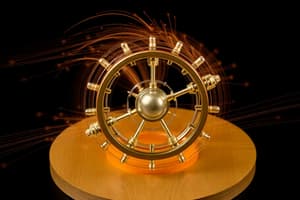Podcast
Questions and Answers
What is electric potential defined as?
What is electric potential defined as?
- The rate of flow of electric charge
- The force per unit charge experienced by a particle
- The work done per unit charge to move a charge from infinity to a point in the field (correct)
- The energy stored in a capacitor
Which law relates the magnetic field to the current producing it?
Which law relates the magnetic field to the current producing it?
- Ampere's Law (correct)
- Coulomb's Law
- Maxwell's Equations
- Ohm's Law
What type of optical phenomenon involves the bending of light?
What type of optical phenomenon involves the bending of light?
- Refraction (correct)
- Dispersion
- Diffraction
- Reflection
Which of the following describes a transverse wave?
Which of the following describes a transverse wave?
What principle describes the net displacement of a medium when multiple waves interact?
What principle describes the net displacement of a medium when multiple waves interact?
Which phenomenon is associated with the concept of wave-particle duality?
Which phenomenon is associated with the concept of wave-particle duality?
What does special relativity primarily deal with?
What does special relativity primarily deal with?
What aspect of physics does nuclear physics focus on?
What aspect of physics does nuclear physics focus on?
What does Newton's first law state?
What does Newton's first law state?
According to Newton's second law, how is acceleration defined?
According to Newton's second law, how is acceleration defined?
What does the law of conservation of energy state?
What does the law of conservation of energy state?
What is the second law of thermodynamics concerned with?
What is the second law of thermodynamics concerned with?
Which equation represents the first law of thermodynamics?
Which equation represents the first law of thermodynamics?
In classical mechanics, what does momentum represent?
In classical mechanics, what does momentum represent?
What does Gauss's law relate to?
What does Gauss's law relate to?
Which of the following best defines thermal equilibrium?
Which of the following best defines thermal equilibrium?
Flashcards
Classical Mechanics
Classical Mechanics
The study of how macroscopic objects move, neglecting quantum effects. It covers concepts like force, mass, acceleration, momentum, and energy.
Newton's First Law
Newton's First Law
An object at rest stays at rest, and an object in motion stays in motion with the same speed and direction unless acted upon by an unbalanced force.
Newton's Second Law
Newton's Second Law
The acceleration of an object is directly proportional to the net force acting on it and inversely proportional to its mass. (F = ma)
Newton's Third Law
Newton's Third Law
Signup and view all the flashcards
Thermodynamics
Thermodynamics
Signup and view all the flashcards
First Law of Thermodynamics
First Law of Thermodynamics
Signup and view all the flashcards
Second Law of Thermodynamics
Second Law of Thermodynamics
Signup and view all the flashcards
Electromagnetism
Electromagnetism
Signup and view all the flashcards
Electric Potential
Electric Potential
Signup and view all the flashcards
What creates magnetic fields?
What creates magnetic fields?
Signup and view all the flashcards
Ampere's Law
Ampere's Law
Signup and view all the flashcards
Faraday's Law
Faraday's Law
Signup and view all the flashcards
Electromagnetic Waves
Electromagnetic Waves
Signup and view all the flashcards
Optics
Optics
Signup and view all the flashcards
Refraction
Refraction
Signup and view all the flashcards
Waves
Waves
Signup and view all the flashcards
Study Notes
Classical Mechanics
- Classical mechanics describes the motion of macroscopic objects, neglecting quantum effects.
- Key concepts include Newton's laws of motion, which relate force, mass, and acceleration.
- Newton's first law: An object at rest stays at rest and an object in motion stays in motion with the same speed and in the same direction unless acted upon by an unbalanced force.
- Newton's second law: The acceleration of an object is directly proportional to the net force acting on it and inversely proportional to its mass. (F=ma)
- Newton's third law: For every action, there is an equal and opposite reaction.
- Concepts like momentum (mass x velocity) and energy (kinetic, potential, etc.) are central to understanding motion and interactions.
- Conservation of momentum states that the total momentum of an isolated system remains constant.
- Conservation of energy states that energy can neither be created nor destroyed, only transformed from one form to another.
- In classical mechanics, motion is deterministic; given the initial conditions, future motion can be precisely predicted.
- Examples include projectile motion, circular motion, and simple harmonic motion.
Thermodynamics
- Thermodynamics describes the relationships between heat, work, and energy.
- Key concepts include temperature, heat, and internal energy.
- The zeroth law of thermodynamics defines thermal equilibrium.
- The first law of thermodynamics states that energy can neither be created nor destroyed, only transferred or transformed. ΔU = Q - W (change in internal energy equals heat added minus work done)
- The second law of thermodynamics states that the total entropy of an isolated system can never decrease over time.
- The third law of thermodynamics describes the behavior of systems as their temperature approaches absolute zero.
- Concepts such as entropy, enthalpy, and free energy are important for understanding energy transformations.
- Thermodynamics has applications in engines, refrigerators, and other thermal devices.
Electromagnetism
- Electromagnetism describes the interaction between electric and magnetic fields.
- Key concepts include electric charge, electric field, electric potential, magnetic field, and magnetic force.
- Coulomb's law describes the force between two point charges.
- Gauss's law relates the electric flux through a closed surface to the enclosed charge.
- Electric potential is defined as the work done per unit charge to move a charge from infinity to a point in the field.
- Magnetic fields are produced by moving electric charges or changing electric fields.
- Ampere's law relates the magnetic field to the current producing it.
- Faraday's law describes how a changing magnetic field induces an electromotive force (EMF) and hence current.
- Electromagnetic waves are waves that carry energy and momentum through space at the speed of light.
- Applications include electric motors, generators, and communication systems.
Optics
- Optics deals with the behavior of light.
- The behavior of light is described by the laws of reflection and refraction.
- Reflection is the bouncing of light off a surface.
- Refraction is the bending of light as it passes from one medium to another.
- Key concepts include lenses, mirrors, and diffraction.
- Types of optical phenomena include rainbows, mirages, and polarization.
- Applications include telescopes, microscopes, and eyeglasses.
Waves
- Describes phenomena that propagate through space such as sound, water, and light.
- Characteristics include amplitude, wavelength, frequency, and speed.
- Wave interference refers to the interaction of two or more waves.
- Types of waves include transverse and longitudinal.
- Superposition principle describes that the net displacement of a medium that involves more than one wave is the sum of the displacements from each individual wave.
- Key properties of waves include reflection, refraction, diffraction, and interference.
Modern Physics
- Modern physics extends classical physics to include quantum mechanics and relativity.
- Quantum mechanics describes the behavior of matter and energy at the atomic and subatomic levels.
- Key concepts in quantum mechanics include quantization of energy, wave-particle duality, and the uncertainty principle.
- Relativity describes the relationship between space and time.
- Special relativity deals with the motion of objects at speeds approaching the speed of light.
- General relativity describes the effects of gravity on space and time.
- Nuclear physics deals with the structure and properties of atomic nuclei.
Studying That Suits You
Use AI to generate personalized quizzes and flashcards to suit your learning preferences.




